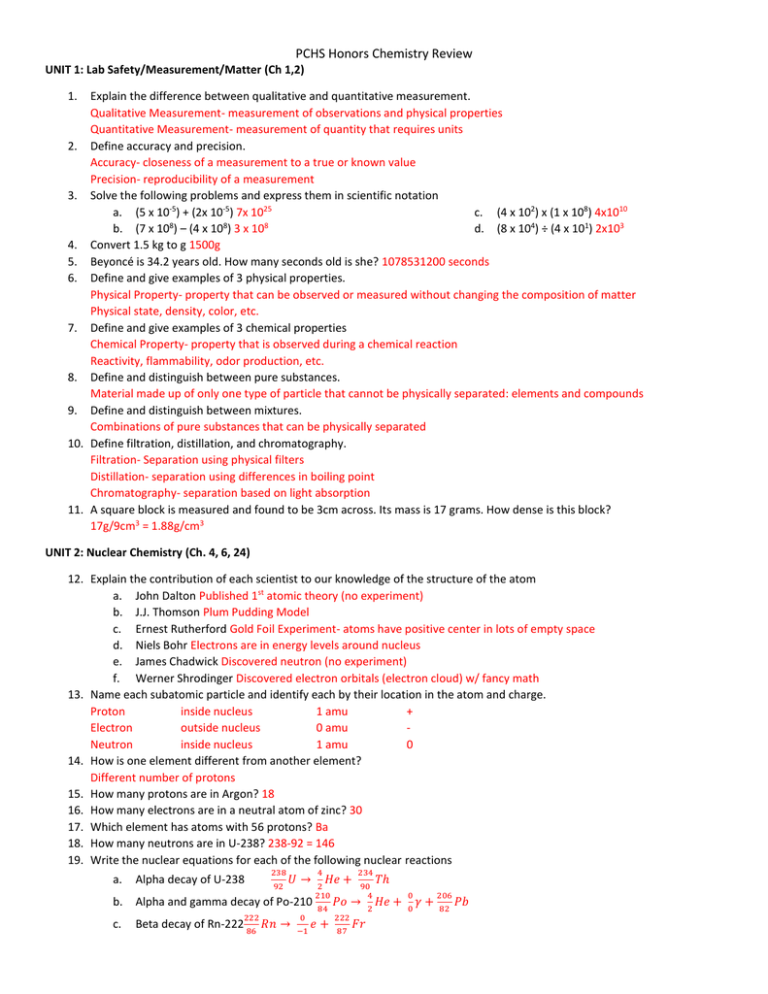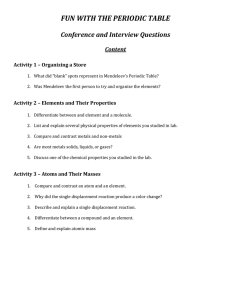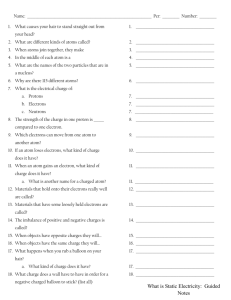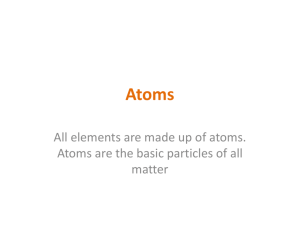FInal Exam Study Guide KEY
advertisement

PCHS Honors Chemistry Review UNIT 1: Lab Safety/Measurement/Matter (Ch 1,2) 1. Explain the difference between qualitative and quantitative measurement. Qualitative Measurement- measurement of observations and physical properties Quantitative Measurement- measurement of quantity that requires units 2. Define accuracy and precision. Accuracy- closeness of a measurement to a true or known value Precision- reproducibility of a measurement 3. Solve the following problems and express them in scientific notation a. (5 x 10-5) + (2x 10-5) 7x 1025 c. (4 x 102) x (1 x 108) 4x1010 8 8 8 b. (7 x 10 ) – (4 x 10 ) 3 x 10 d. (8 x 104) ÷ (4 x 101) 2x103 4. Convert 1.5 kg to g 1500g 5. Beyoncé is 34.2 years old. How many seconds old is she? 1078531200 seconds 6. Define and give examples of 3 physical properties. Physical Property- property that can be observed or measured without changing the composition of matter Physical state, density, color, etc. 7. Define and give examples of 3 chemical properties Chemical Property- property that is observed during a chemical reaction Reactivity, flammability, odor production, etc. 8. Define and distinguish between pure substances. Material made up of only one type of particle that cannot be physically separated: elements and compounds 9. Define and distinguish between mixtures. Combinations of pure substances that can be physically separated 10. Define filtration, distillation, and chromatography. Filtration- Separation using physical filters Distillation- separation using differences in boiling point Chromatography- separation based on light absorption 11. A square block is measured and found to be 3cm across. Its mass is 17 grams. How dense is this block? 17g/9cm3 = 1.88g/cm3 UNIT 2: Nuclear Chemistry (Ch. 4, 6, 24) 12. Explain the contribution of each scientist to our knowledge of the structure of the atom a. John Dalton Published 1st atomic theory (no experiment) b. J.J. Thomson Plum Pudding Model c. Ernest Rutherford Gold Foil Experiment- atoms have positive center in lots of empty space d. Niels Bohr Electrons are in energy levels around nucleus e. James Chadwick Discovered neutron (no experiment) f. Werner Shrodinger Discovered electron orbitals (electron cloud) w/ fancy math 13. Name each subatomic particle and identify each by their location in the atom and charge. Proton inside nucleus 1 amu + Electron outside nucleus 0 amu Neutron inside nucleus 1 amu 0 14. How is one element different from another element? Different number of protons 15. How many protons are in Argon? 18 16. How many electrons are in a neutral atom of zinc? 30 17. Which element has atoms with 56 protons? Ba 18. How many neutrons are in U-238? 238-92 = 146 19. Write the nuclear equations for each of the following nuclear reactions 238 𝑈→ a. Alpha decay of U-238 b. Alpha and gamma decay of Po-210 c. Beta decay of Rn-222 92 222 86 𝑅𝑛 → 0 −1 4 𝐻𝑒 + 2 210 84 𝑒+ 234 90 4 𝑃𝑜 → 222 87 𝐹𝑟 2 𝑇ℎ 𝐻𝑒 + 0 0 𝛾+ 206 82 𝑃𝑏 PCHS Honors Chemistry Review d. Beta and gamma decay of Cm-245 245 96 𝐶𝑚 → 0 −1 0 245 0 97 𝑒+ 𝛾+ 𝐵𝑘 20. What is an isotope? An atom with a different number of neutrons 21. Why is the mass of each element on the periodic table a decimal number? Average mass of all the isotopes of that element 22. Neon consists of three common isotopes Ne-20, Ne-21, Ne-22. Which isotope of neon is most abundant? Ne-20; closest to the average 20.18 23. Element X consists of three isotopes, 65.43% X-45, 30.51% X-44, and 4.06% X-46. Determine the average atomic mass of the element X. 45(.6543) + 44(.3051) + 46(.0406) = 44.74 amu 24. Determine the percent abundancy of each isotope in a sample of element Z with an averate atomic mass of 34.68. The isotopes are Z-33 and Z-35. 34.68= 33(x) + 35(1-x) = 33x + 35-35x -.32=/2x Z-33: 16% Z-35: 84% 25. Compare and Contrast nuclear fission and nuclear fusion. Nuclear Fission: Large unstable nuclei break apart into smaller nuclei Nuclear Fusion: Small nuclei fuse together to form new elements 26. Bandages can be sterilized by exposure to gamma radiation from cobalt-60, which has a half-life of 5.27 yr. How much of a 10.0 mg sample will be left after 1 half life? 5 half-lives? 1 half life: 5 mg 5 half-lives: .3125mg UNIT 3: Electrons and the Periodic Table (Ch.5) 27. 28. 29. 30. 31. 32. 33. How is an ion different from a neutral atom? Different number of electrons (charged) How is a cation different from an anion? Cation has a positive charge, anion has a negative charge Identify the number of electrons in a P-3 ion. 18 eWhat is the charge on lead with 78 electrons? +4 Why do atoms form into ions? To become more stable What electron configuration do most ions form? Noble gas configuration How is the structure of the periodic table related to electron configurations? s d p 34. Why does the 4s orbital fill before the 3d orbital? 4s has less energy 35. Write the electron configurations for Fe and Ag+1. Fe: 1s22s22p63s23p64s23d6 Ag+1: 1s22s22p63s23p64s23d104p65s24d8 36. What causes the different colors of light seen during a flame test? e- FALLING in energy levels 37. What color is characteristic of the flame test for: Li, K, Cu, Ca, Ba, Sr? Li: hot pink/magneta K: purple/lavender Cu: blue green Sr: Red orange Ca: orange Na: Orange Ba: Yellow 38. Explain how Hund’s Rule and the Pauli Exclusionary Principle relate to electron configuration. Hund’s Rule: e- fill lowest energy levels first; Pauli Exclusionary Principle: 1 e- per sublevel first, then 2e- if they have opposite spins 39. Identify and explain the following trends as seen on the periodic table: a. Atomic radius size of atom. Decreases c. Electronegativity ability to hold onto/pull a across, increases down shared electron. Increase across, decrease b. Ionization energy the energy needed to down remove an electron. Increases across, d. Metal vs. nonmetal properties decreases down PCHS Honors Chemistry Review Metals: react w/ acid; shiny, malleable, lose e-, conduct electricity, form positive ions. Nonmetals: do not react w/ acid, not shiny, brittle, gain e-, do not conduct electricity, form negative ions 40. Where are metalloids found on the periodic table? Stair step line UNIT 4: Bonding and Molecular Shapes (Ch. 7-8) 41. 42. 43. 44. 45. 46. 47. 48. 49. 50. What is an ionic bond? Give an example of an ionic compound transfer of e- between a metal and a nonmetal; NaCl List properties of ionic compounds. Strong, form crystal lattice structure, high melting and boiling points, not brittle What is a covalent bond? Give an example of a molecular compound shared electrons between 2 nonmetals; CO2 List properties of molecular compounds Weak, low melting points, brittle What determines if a covalent bond is polar or nonpolar? Polar: unequal sharing of electrons; Nonpolar: equal sharing of electrons (can determine by using electronegativity values) Explain the intermolecular forces: dipole-dipole, H-bonding, and London Forces (Induced Dipole) Dipole-Dipole: found in polar molecules; movement of eHydrogen Ponding: found in polar molecules; when H bonds to N,O,F London Disperson Forces: between nonpolar molecules; caused by random movement of unshared eWhat types of compounds will exhibit each of these forces? See above Explain why H2O has a much higher boiling point than H2S. H2O has stronger intermolecular forces with H bonds What is VSEPR Theory and how does it help us to predict the shapes of molecules? Valence Shell Electron Pair Repulsion: valence electrons repel so the molecule will adjust its shape so that the electrons are as far apart as possible Draw electron dot structures for the following molecules. Identify the shape of the molecule a. NH3 Trigonal Pyramidal b. c. HF Linear d. H2S bent f. g. h. i. Aluminum hydroxide Al(OH)3 Lead(IV) oxide PbO2 Carbon tetrachloride CCl4 Carbon dioxide CO2 b. 3,4,5-triethyloctane SO42- Tetrahedral UNIT 5: Nomenclature and Chemical Reactions (Ch. 7-8,21) 51. Name the following compounds: a. HNO3 nitric acid b. Pb(C2H3O2)2 lead (II) acetate c. NO2 Nitrogen Dioxide d. CaCl2 calcium chloride e. P2S5 diphosphorus pentasulfide 52. Draw the following compounds: a. 2,3-dimethyl-5-propyldecane 53. Name the following compound: PCHS Honors Chemistry Review 54. Use the following balanced equation to answer the following: P4(s) + 3O2(g) 2P2O3(s) a. Name the products phosphorus b. Name the reactants oxygen c. What total number of atoms is in the products? 10 d. What are the number of atoms are in the reactants? 10 55. Define the Definite Proportions. A change in subscripts in a compound causes a change in the compound 56. Define the Law of Multiple Proportions. The same elements can combine in different ratios to form new compounds 57. Balance the following Chemical Equations a. 2C4H10 + 13O2 8CO2 + 10H2O b. 1Cu + 4HNO3 1Cu(NO3)2 + 2NO2 + 2H2O c. 2Na + 2H2O 2NaOH + H2 58. Identify the type of reactions below. Write and balance the equations. a. Lead (II) nitrate + sodium phosphate sodium nitrate + lead (II) phosphate DR: 3Pb(NO3)2 + 2 Na3PO4 6NaNO3 + Pb3(PO4)2 b. Sodium + oxygen sodium oxide Synthesis: 2Na + O2 Na2O c. Aluminum hydroxide aluminum oxide + water Decomp: 2Al(OH)3 Al2O3 + 3H2O d. Tricarbon hexahydride + oxygen carbon dioxide + water Combustion: 2C3H6 + O2 6CO2 + 6H2O UNIT 6: The Mole and Stoichiometry (Ch. 10, 11) 59. Determine the molar mass of C3H7O3N 105.0g 60. Determine the mass in grams of 1 atom of zinc. 1 atom x 65.4𝑔 6.022𝑥1023 𝑎𝑡𝑜𝑚𝑠 = 1.09 x 10-22 61. How many molecules are in a 65.4 g sample of carbon dioxide? 65.4g CO2 x 6.022𝑥1023 𝑚𝑜𝑙𝑒𝑐𝑢𝑙𝑒𝑠 44.0𝑔 𝐶𝑂2 = 8.95 x 1023 molecules 62. What number of moles is 8.6 x 1024molecules of sulfur? 8.6 x 1024molecules x 1 𝑚𝑜𝑙𝑒 6.022 𝑥 1023𝑚𝑜𝑙𝑒𝑐𝑢𝑙𝑒𝑠 = 14 moles 63. What number of aluminum atoms is in a 65.8 g sample of aluminum oxide? 65.8gAl2O3 x 6.022 𝑥 1023 𝑚𝑜𝑙𝑒𝑐𝑢𝑙𝑒𝑠 𝐴𝑙2𝑂3 𝑔𝐴𝑙2𝑂3 x 2 𝑎𝑡𝑜𝑚𝑠 𝐴𝑙 1 𝑚𝑜𝑙𝑒𝑐𝑢𝑙𝑒 = 7.77 x 1023 atoms 64. Determine the empirical formula of a compound that contains 25.44% copper, 12.84% sulfur, 4.036% hydroge, and 57.76% oxygen. DOES NOT WORK (WRONG NUMBERS) 65. What is the percent of oxygen in sodium sulfate? Na2SO4 64.0 142.1 = 45.0% 𝑂 66. Determine the molecular formula of a compound having an empirical formula of CH2 and a molecular weight of 84? Molecular/empirical = 6 C6H12 Consider the following reaction: C3H8 + 5O2 3CO2 + 4H2O 67. Determine the mass of water formed by complete reaction of 68.5g of C3H8 68.5 g C3H8 x 4(18.0𝑔)𝐻2𝑂 1(44.0𝑔)𝐶3𝐻8 = 112g H2O 68. What number of moles of carbon dioxide will form from reaction of 46.2 moles of oxygen? 46.2 moles O2 x 3 𝑚𝑜𝑙𝑒𝑠 𝐶𝑂2 5 𝑚𝑜𝑙𝑒𝑠 𝑂2 = 27.7 moles CO2 69. If 685.2g C3H8 react and 10005g of water is formed, what is the percent yield of the reaction? 685.2g C3H8 x 4(18.0𝑔)𝐻2𝑂 1(44.0𝑔)𝐶3𝐻8 = 1,120g H2O 70. If 500g of C3H8 is mixed with 500g of oxygen, PCHS Honors Chemistry Review a. b. c. What mass of carbon dioxide is formed? 413 g CO2 Which reactant is in excess? C3H8 How much is left over? 362g UNIT 7: Thermodynamics (Ch.15) 71. Describe the arrangement of particles in the 3 states of matter in terms of their kinetic energy Solid- low KE, atoms held tightly together Liquid- Medium KE, atoms touching but flowing past each other Gas- High KE, Atoms pinging around like crazy 72. How many J would it take to raise the temperature of 200 g of water from 5 oC to 85oC? Q = (200 g)(4.18)(80 oC) = 66880 J 73. What is the specific heat capacity of a substance if 750J caused 100g of it to go from 90 oC to 135oC? 750 J = (100 g)(x)(45 oC) = 0.167 J/gC 74. What is the Latent heat of Fusion of a substance? Heat of Vaporization? Heat of Fusion: Energy needed to melt or freeze Heat of Vaporization: Energy needed to boil or condense 75. What do you call each of the following changes of state? a. Solid to liquid melting d. Solid to gas sublimation b. Liquid to gas vaporization e. Liquid to solid freezing c. Gas to solid deposition f. Gas to liquid condensation 76. A piece of ice is placed on the sidewalk on a hot summer day. Describe what happens to energy content of the piece of ice, does it gain or lose energy? What happens to the air around the ice, does it gain or lose energy? The ice gains energy from the surrounding air and increases its energy (endothermic). The air loses energy to the ice and decreases its energy (exothermic) 77. 100 grams of hot water at 80 oC is combined with 100 grams of cool water at 20 oC. What is the final temperature of the combined water? Qlost = - Qgain mc(Tf – Ti) = - mc(Tf – Ti)(100 g)(4.18)(x- 80 oC) = - (100 g)(4.18)(x- 20 oC) Tf = 50 oC 78. Describe each of the reactions below as endothermic or exothermic. a. Exploding fireworks exothermic c. Lava cooling exothermic b. Melting snow endothermic d. Water evaporating endothermic 79. What is a calorimeter used for? Measure energy lost or gained by a system 80. Define Enthalpy. Give an example of three ways a change in enthalpy can be shown. Enthalpy: measure of a change in heat of a system Thermochemical Equation, Energy Diagrams, H 81. Compare and Contrast Spontaneous and Nonspontaneous reactions. Spontaneous Reactions- Occur without outside intervention, proceed in one direction, nonreversible Nonspontaneous Reactions- Require outside force to cause a change 82. Define Entropy and relate it to a change of state/temperature. Entropy- degree of randomness or chaos in a system Solid- Low Temp, Low Entropy Liquid- Higher Temp, Medium Entropy Gas- High Temp, High Entropy 83. Summarize each of the laws of Thermodynamics. 1st Law: Energy in the universe is constant, it can neither be created nor destroyed, only change forms 2nd Law: Entropy in the Universe is decreasing 3rd Law: At absolute zero, the entropy of a pure substance is 0 UNIT 8: Acids/Bases/Solutions/Kinetics (Ch.16-18) 84. Identify the following conjugates: a. Conjugate base of H2SO4 SO4 b. Conjugate base of NH4+ NH3 c. d. Conjugate acid of H2O H3O+ Conjugate acid of HAsO42- H2AsO4- PCHS Honors Chemistry Review 85. Label the conjugate acid-base pairs in the reaction below: HCO3- + OH- (aq)CO32- (aq) + H2O(l) Acid Base C.B C. A 86. What are two products of an Arrhenius neutralization reaction? Salt and water 87. Compare and contrast properties of acids and bases Acids- Sour, pH<7, turn blue litmus red, corrosive, produces H gas in contact w/ metal Base- bitter pH>7, turn red litmus blue, corrosive, soap, slippery 88. What mass of potassium nitrate will dissolve in 100g of water at 60oC? 95g 89. How many more or less grams of potassium chloride will dissolve in 100g of water at 60 oC than grams of potassium nitrate in the above question? 55g less 90. What mass of potassium chloride will dissolve in 50g of water at 70oC? 25g 91. What is the effect of an increase in temperature on the solubility of a solid? Explain your answer. Increase in temperature = increase in solubility 92. What is the effect of an increase in temperature on the solubility of a gas? Increase in temperature = decrease in solubility 93. List 4 things that affect the rate of solution of a solute. Temperature, surface area, stirring, amount of solute already dissolved 94. Determine the molarity of sodium chloride in a solution that contains 10.5g NaCl dissolved in 750 mL of total solution. .35M 95. What volume of 0.35 M CoCl2 is needed to obtain 5.35 moles CoCl2? .065L 96. Describe the changes in the rate of reaction based on the following changes in the system: a. Increased temperature increased rate d. Pressure on a gas increased rate b. Increased Concentration decreased rate e. Adding Catalysts increased rate c. Decreased particle size increased rate 97. What does it mean for a reaction to be in equilibrium? Forward and reverse rate is equal 98. Use LeChatelier’s Principle to predict the shift in equilibrium for the following: 3H2(g) + N2(g) + heat 2NH3(g) a. When more NH3 is added shifts towards reactants b. When N2 is removed shifts towards reactants c. When H2 is added shifts towards products d. When pressure is increased shifts towards products e. When temperature is decreased shifts towards products






